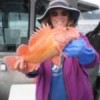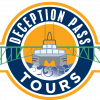Notifications










Before this landmark was built, travelers had to cross on an unscheduled ferry. To summon the ferry, passengers would simply hit a mallet against a metal lumberjack saw which sounded the “BOING” to the operator. This indicated they were ready to cross, and the first woman ferry boat captain in Washington would pick them up.
Today, riding through the pass is much easier, tickets can be purchased for Deception Pass Tours at the ticket booth in the parking lot at the south end of the bridge.
Learn more about the ferry and the first female ferry captain on your tour!
Have you ever wondered what it would be like to be smuggled into the US in a burlap bag? In the early 1900’s there were plenty of people who got to have that experience courtesy of Ben Ure. Find out what he did with his cargo when he was outrunning the law on your Deception Pass Tour aboard the Island Whaler.
The prison rock quarry operated from 1910 through 1914, and its nearby barracks housed some 40 prisoners, members of an honors program out of Walla Walla prison.
The prison population was made up of all kinds of prisoners, even murderers. Guards stood at the quarry as the prisoners cut the rock into gravel and loaded onto barges located at the base of the cliff top and the Pass waters. The quarried rock was taken by barge to the Seattle waterfront. The rock was a lot better than the sawdust Seattle was originally built on!
At peak current at over 8 knots (9.5 mph) almost 900 million gallons of water pour through Deception Pass. That’s 50 times more flow that all the rivers in the Puget Sound. You can see why there is a 4.5 foot height difference in the water level from one side of the pass to the other!
But don’t worry, the boat is equipped with latest safety equipment. Captain Brett and crew will ensure safe passage and an entertaining time for all!
The Island Whaler is a New Zealand designed jet drive catamaran. The catamaran style and foil assist ensures a soft and stable ride in any conditions. The open deck seating will give you the best 360° viewing opportunity and interaction with the surrounding elements.
The bridge, one of the scenic wonders of the Pacific Northwest, is actually two spans, one over Canoe Pass to the north, and another over Deception Pass to the south. Construction began in August 1934, and the completed bridge was dedicated at noon on July 31, 1935. The Wallace Bridge and Structural Co. of Seattle, Washington provided 460 tons of steel for the 511-foot Canoe Pass arch and 1130 tons for the 976-foot Deception Pass span. The cost of construction was $482,000.
In September 1982, the bridge was declared a National Historic Landmark. It cost more to paint the spans in 1983 than it did to build them in 1935. They were painted again in 1997.
Keep up to date on all the latest happenings, special events, and promotions.
"*" indicates required fields